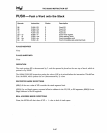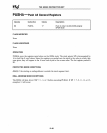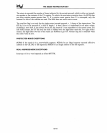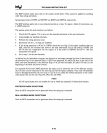
THE
80286
INSTRUCTION SET
The REP prefixes make sense only
in
the contexts listed above. They cannot
be
applied
to
anything
other than string operations.
Synonymous forms of REPE and REPNE are REPZ and REPNZ, respectively.
The REP prefixes apply only
to
one
string instruction at a time.
To
repeat a block of instructions, use
a
LOOP construct.
The precise action for each iteration
is
as
follows:
1.
Check the CX register.
If
it
is
zero, exit the iteration and
move
to
the next instruction.
2.
Acknowledge any pending interrupts.
3.
Perform the string operation once.
4.
Decrement CX
by
1;
no
flags are modified.
5.
If
the string operation
is
SCAS
or
CMPS, check the zero flag.
If
the repeat condition does not
hold, then exit the iteration and
move
to
the next instruction. Exit if the prefix
is
REPE and
ZF=O
(the last comparison
was
not equal), or if the prefix
is
REPNE and
ZF=1
(the last
comparison
was
equal).
6.
Go
to
step 1 for the next iteration.
As
defined
by
the individual string-ops, the direction of movement through the block
is
determined
by
the direction flag.
If
the direction flag
is
1 (STD
was
executed), SI and/or DI start at the end of the
block and
move
backward; if the direction flag
is
0 (CLD
was
executed), SI and/or DI start at the
beginning of the block and
move
forward.
For repeated
SCAS and CMPS operations the repeat can
be
exited
for
one of
two
different reasons:
the CX count can
be
exhausted or the zero flag can fail the repeat condition. Your code
will
probably
want
to
distinguish between the
two
cases.
It
can
do
so
via either the JCXZ instruction or the condi-
tional jumps that test the zero flag (JZ, JNZ, JE, and JNE).
NOTE
Not
all
input/output ports can handle the rate at which the repeated
I/O
instructions execute.
PROTECTED MODE EXCEPTIONS
None
by
REP; exceptions can be generated when the string-op
is
executed.
REAL ADDRESS MODE EXCEPTIONS
None by REP; exceptions can
be
generated when the string-op
is
executed.
8-93


















